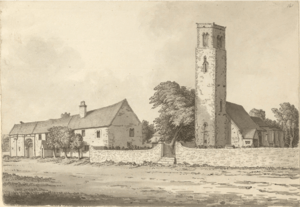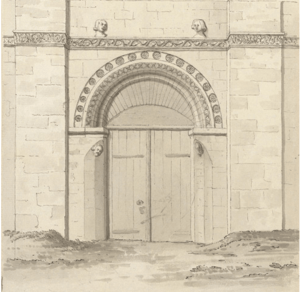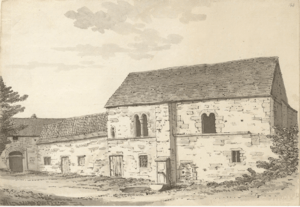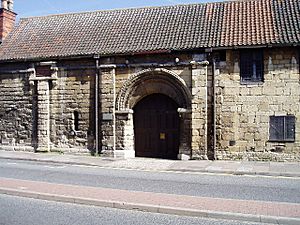St Mary's Guildhall, Lincoln facts for kids
Quick facts for kids St Mary's Guildhall, High Street, Lincoln |
|
|---|---|
 |
|
| Location | Lincoln |
| Built | 12th century |
| Architectural style(s) | Medieval stone hall house complex |
|
Listed Building – Grade I
|
|
| Designated | 8 October 1953 |
| Reference no. | 486049 |
| Lua error in Module:Location_map at line 420: attempt to index field 'wikibase' (a nil value). | |
St Mary's Guildhall is a very old and important building in Lincoln, England. It was built in the 12th century, a long time ago! It's located in an area of the city called Wigford, right on Lincoln High Street. This grand building was likely home to someone very important because of its large size and fancy design. It stands near the old St Peter at Gowts church.
Contents
A Look Back: The History of St Mary's Guildhall
People now believe that St Mary's Guildhall was built as a royal palace for King Henry II. It was probably finished by 1157. Even though we aren't totally sure it belonged to the King before 1228, it was certainly a very important place.
Who Owned the Guildhall?
In 1251, the building was sold by Michael de la Burne, who was the butler for King Henry III. He sold it to a group called the Guild of St Mary of Lincoln. A guild was like a club or association for people who did the same job or shared common interests.
The Guild of St Mary owned the building until 1547. After that, it became the property of the Lincoln City Council. For many years, the council rented it out to different people.
In 1614, the Guildhall was leased to a new school called Lincoln Christ's Hospital School. This was a "Bluecoat school," which meant the students wore special blue uniforms. The school stayed there until 1633, even though they had moved to a new location near Lincoln Cathedral in 1623.
Later, the Fawkes family rented parts of the building. In 1815, a Member of Parliament named Coningsby Waldo Sibthorp leased it. Records show that part of the building was used for "malting," which is a step in making beer.
After a law change in 1835, Sibthorp's son, Charles de Laet Sibthorp, was able to buy the Guildhall and the land behind it. This land, called the paddock, became the first home for the Lincoln City Football Club from 1884 to 1895.
Over time, a family of builders called Lucas took over the leases. The malting area was rented by a brewing company until about 1913. In the 1890s, new streets were built, and some older parts of the Guildhall were taken down to make way for Sibthorp Street.
Saving the Guildhall
In 1930, St Mary's Guildhall was officially recognized as a scheduled monument. This means it's a very important historical site that needs to be protected.
After Coningsby Charles Waldo Sibthorp passed away in 1932, people tried to raise money to buy the Guildhall. However, in 1938, the City Council bought it themselves. The Lucas family continued to use it as a builder's yard until 1981.
From 1981 to 1986, archaeologists carefully dug up and studied the buildings. Then, from 1984 to 1986, the Guildhall was restored to its former glory. Today, it is used as offices for the Lincoln Civic Trust and as a church hall.
What Was Here Before the Guildhall?
During the excavations in 1982 and 1983, archaeologists found exciting clues about what was on the site even before the Guildhall was built. They discovered parts of an ancient Roman road called Fosse Way right under the front of the Guildhall. It seems to have met another Roman road, Ermine Street, at this spot.
They also found remains of two Roman buildings from the 3rd century AD. These buildings had stone foundations and wooden frames. The Roman road even showed deep ruts from carts, proving it was a busy route! There was also evidence of structures and rubbish pits from the Late Saxon period, between the 10th and 12th centuries.
Was St Mary's Guildhall a Royal Palace?
It's a big question whether St Mary's Guildhall was truly a royal palace for King Henry II. We know it wasn't built for the Guild of St Mary, and it existed before they bought it in 1251/2. This makes it possible it was a royal "hospicium," which was like a guesthouse or palace for the king.
King Henry II's Visit to Lincoln
King Henry II visited Lincoln at Christmas in 1157. During this visit, he had a special ceremony where he wore his crown again, or had a second crowning. We know from a historian named Roger of Hoveden that Henry II had palaces in other cities like Oxford and Winchester. Roger also mentioned a palace in the Wigford area of Lincoln.
In the same year, King Henry spent money on "repairs" to his "Hospicium" and also on his group of huntsmen and squires who were with him.
Evidence for a Royal Palace
Historian David Stocker believes that St Mary's Guildhall is the most likely building in Wigford to have been Henry's palace. Stone pieces found from the building, especially those with fancy leaf designs (called acanthus) and spiral shapes (called volutes), can be dated to around 1150–1170. This fits perfectly with when the Guildhall was built. The word "repairs" used in 1157 often meant the final costs of finishing a new building.
Stocker's main argument is that St Mary's Guildhall was built on a much grander scale than other Romanesque houses in Lincoln, like the Norman House or Jew's House. The main hall on the first floor of the Guildhall is huge, measuring about 20 meters by 6.5 meters. This makes it one of the largest surviving 12th-century halls!
However, some records about who owned the Guildhall earlier don't quite fit this idea, even though King Henry III definitely owned the property later. It's thought that a man named John de Holm owned it first. He sold it in 1228 to King Henry. The King seemed to use it for storing wine before selling it to his butler in 1250, who then sold it to the Guild of St Mary in 1250/1. But because the exact property lines are a bit unclear, it's still possible that Henry III was just adding to land he already owned, so the idea of it being a royal palace isn't completely ruled out.
Drawings by Samuel Hieronymous Grimm

One of the best ways we know about the Guildhall's past is through the detailed drawings of Samuel Hieronymous Grimm. He was a Swiss artist who made many drawings of buildings around 1784. Many of his drawings are in the British Library, and some are in the Usher Gallery in Lincoln.
Grimm made four drawings of St Mary's Guildhall. One shows the High Street with St Peter at Gowts church on the right and the Guildhall on the left. Some of the houses shown in his drawings were later taken down in 1896 to build Sibthorp Street.
Grimm also drew a very detailed picture of the main entrance. It shows the arch decorated with flowers and a "dogtooth" pattern, plus two carved heads on the door frame. One of these heads looks like a bishop. Above the arch, there's a decorative band with two more heads.
His drawings and later studies show that the Guildhall originally had a large hall on the first floor. This hall had five Romanesque windows, similar to other old buildings in Lincoln. The front of the building also had two tall chimneys. Grimm also drew the Norman House, which is in the courtyard behind the Guildhall. Even though this building has old-looking windows, it was probably rebuilt in the early 1600s. The old windows might have been reused from other buildings. The Norman House was later used for malting and storing barley.
The Building's Design
The front of St Mary's Guildhall faces Lincoln High Street. It has five sections, with shallow supports (called buttresses) and a decorative band of Romanesque designs featuring bird and animal faces on the northern part.
Near the middle of the stone front is a large archway for carriages. It has a rounded inner arch and is flanked by single buttresses. Above this arch are two carved masks that were placed there later.
In the courtyard behind the Guildhall is a two-story building called the Norman House. It has two sections and a shallow buttress in the middle. The lower south part of the building, which faces Sibthorp Street, now serves as the church hall for St Peter's at Gowts Church. It includes several old 12th-century pieces that were reused.
Images for kids
More to Explore: Medieval Buildings in Lincoln
- Whitefriars, 333 High Street, Lincoln
- Jew's House
- Jew's Court
- John of Gaunt's Palace, Lincoln





